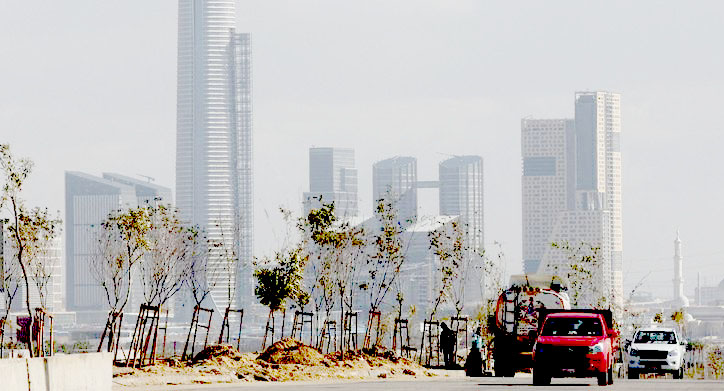Egypt Grapples with Mounting External Debt Burden amid Borrowing Spree

CAIRO (Reuters) – Egypt finds itself in an increasingly arduous predicament as it struggles to secure funds for repaying its foreign debt. Over the past eight years, the country’s external borrowing has quadrupled, primarily aimed at financing ambitious projects such as constructing a new capital, developing infrastructure, acquiring weaponry, and sustaining an overvalued currency.
Regrettably, few of these grand endeavors have resulted in substantial inflows of hard currency, exacerbating Egypt’s challenges. Moreover, global borrowing costs have surged, leading foreign investors to shun emerging markets, including Egypt, since the onset of the Ukraine conflict.
While the Egyptian government claims it will meet its debt obligations, it has failed to implement long-promised structural reforms to revitalize the economy. Additionally, its attempts to raise cash by selling state assets have yielded no major foreign currency gains in nearly a year.
Monica Malik from Abu Dhabi-based bank ADCB expressed concern, stating, “I think the biggest problem right now is that no one is seeing enough reform. Egypt is waiting for capital flows, and no one I speak to is ready to put that in again until they see the reform.”
Investors have long advocated for a more flexible currency, yet Egypt’s pound has remained static against the dollar for three months, despite pledging to the International Monetary Fund (IMF) to free it up as part of a $3 billion financial package agreed upon in December.
Amid a foreign currency scarcity, Egypt has depleted net foreign assets in its banking system by over $40 billion in the past two years, partially to bolster the value of the pound.
Prime Minister Moustafa Madbouly has sought to reassure investors about the state’s financial stability, stating in April, “I affirm that the Egyptian state has not failed and will not fail to pay any of its international obligations.”
Egypt has announced plans to meet its foreign liabilities and raise funds through asset sales, aiming to generate $2 billion by the end of June. However, the Finance Ministry did not respond to requests for comment regarding these efforts.
SECURING FOREIGN FUNDS
Egypt relies on three primary sources of foreign currency: tourism, Suez Canal transit fees, and remittances from Egyptians working abroad. While tourism and Suez Canal revenues have seen slight increases, the volume of remittances has decreased as more individuals repatriate funds through unofficial markets, as per bankers’ observations.
At the official exchange rate, one US dollar is equivalent to approximately 31 Egyptian pounds, while in the unofficial market, it fetches about 39 pounds.
The scarcity of hard currency raises concerns about Egypt’s ability to meet its foreign debt obligations. Since April, all three major credit rating agencies have downgraded the outlook for Egyptian debt.
Moody’s noted, “Egypt’s large external debt maturity profile is becoming increasingly challenging.”
Upcoming payments include $2.49 billion in short-term debt due in June, followed by $3.86 billion in short-term borrowing and $11.38 billion in long-term debt in the latter half of 2023, according to recent central bank data.
A portion of the debt is owed to friendly lenders, such as Egypt’s Gulf allies, who are expected to roll over the nearly $30 billion they have deposited with the country’s central bank, based on previous experiences.
However, other obligations are owed to less forgiving creditors, including the IMF, which requires a payment of $2.95 billion by the end of 2023, and foreign bondholders expecting $1.58 billion. The repayment schedule remains similarly demanding in the subsequent years.
The combined payments to the IMF and foreign bondholders, totaling around $4.5 billion, exceed half of Egypt
‘s annual earnings from the Suez Canal, which amount to $8 billion.
A BORROWING SPREE
Egypt’s borrowing spree gained momentum following an economic conference in March 2015, less than a year after President Abdel Fattah al-Sisi, a former military general, assumed office. The event marked the announcement of several megaprojects, including a new capital city and three power plants.
Buoyed by IMF agreements in 2016 and 2020, multilateral lenders, foreign governments, and institutional investors eagerly joined the bandwagon. Furthermore, Egypt, having hosted the COP27 climate summit last year, has received substantial financing in the form of green investments.
According to central bank data, Egypt’s external loans soared from under $40 billion in 2015 to $162.9 billion by December 2022. In the final quarter of 2022 alone, borrowing spiked by $8 billion.
While Egypt once enjoyed the favor of the IMF and investors due to its macroeconomic stabilization efforts, this growth has been fueled by borrowed funds, leading to a skewed circular logic. Regrettably, the anticipated returns from the investments have not materialized sufficiently to enhance Egypt’s ability to repay its external debt, cautioned Farouk Soussa from Goldman Sachs.
Economists assert that Egypt, a nation with a population of 105 million and significant reliance on wheat imports, as well as basic food and fuel imports, has directed a substantial portion of the borrowed funds towards projects that will not swiftly generate the required foreign currency.
These projects include a $58 billion new capital city east of Cairo, a $25 billion nuclear power plant on the Mediterranean coast, and a 2,000 km (1,250 miles) high-speed rail network, the world’s sixth-largest, expected to ultimately cost $23 billion, according to presidential statements.
Between 2015 and 2019, Egypt emerged as the third-largest arms importer globally, placing at least 54 weapons orders, as reported by the Stockholm International Peace Research Institute (SIPRI).





